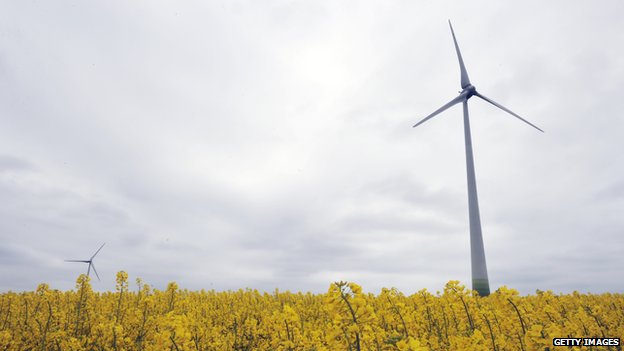 |
| The Commission has outlined new targets for renewables that will be binding at EU level but not for member states |
The European Commission has outlined its plans for climate and energy policy until 2030.
The Commissioners want a binding target to reduce carbon emissions by 40% from 1990 levels.
Renewables will need to provide 27% of EU energy by 2030, but while the target will be binding at EU level there will be no mandatory targets for member states.
The policy proposals are subject to review by heads of government.
Green groups have said the new targets lack ambition and the 40% emissions cut is "dangerously low".
This wide ranging White Paper will have a significant impact on the way Europe generates its power from 2020 onwards.
The Commission wants to give clarity to investors in renewable energy while at the same time maintaining their leadership role in global climate negotiations.
A critical part of that is the headline figure on emissions cuts. The target that was set for 2020 was 20% but the EU as a group had almost reached the goal by 2012.
Some countries including the UK urged the Commission to propose a bigger target of 50% by 2030, others held out for 35%.
Climate commissioner Connie Hedegaard said that, given the economic climate, the 40% target was a significant advance.
"A 40% emissions reduction is the most cost-effective target for the EU and it takes account of our global responsibility," she said.
"If all other regions were equally ambitious about tackling climate change, the world would be in significantly better shape."
Officials emphasised that the 40% target would have to be achieved "through domestic measures alone", meaning that member states couldn't offset their reductions by paying for carbon cutting in other countries.
Binding targetsThe move was welcomed by investors. According to the Institutional Investors Group on Climate Change, who's members manage 7.5 trillion euros, the new target was a good first step.
"A 40% emissions reduction target is the minimum necessary to keep Europe on course for a low-carbon economy as outlined in the EU's 2050 Roadmap," said chief executive Stephanie Pfeifer.
"Achieving this target is well within member state capabilities and crucial for long-term policy certainty."
Despite this, many environmental campaigners were unhappy.
Brook Riley from Friends of the Earth said the target would make the goal of avoiding dangerous climate change, defined as going above 2C, difficult to achieve.
"We say 40% is really dangerously low. This goal means there's about fifty-fifty chance of going over 2 degrees of global warming," he said.
As well as the headline cut in emissions, the other key plank of the White Paper is renewable energy.
The 2007 targets required 20% of all energy to come from solar, wind or other renewable sources.
|
Germany, which is in the middle of a huge transition to solar and wind, was keen to see these binding targets continue after 2020.
Others, including Poland, Spain and the UK, were keen on greater flexibility in the energy mix. The UK was keen to use nuclear energy as a way of meeting its own emissions reduction goal.
The result is a proposal for a binding target across the EU to provide "at least 27%" of energy from renewable sources.
"It is not just an aspirational thing, it's not just a nice intention, it is a binding target we are proposing," said Ms Hedegaard.
But crucially, there are to be no binding targets for individual member states.
Sensitive issueThe Commission President Jose Manuel Barroso said that shale gas was changing the energy landscape in a dramatic way.
There would be no binding EU wide regulations, he said. Instead the EU would set minimum core principles for fracking on environmental safety and health.
There would be a scoreboard for each member state to show how they were meeting the requirements.
"It's a good demonstration of the role the EU should play, setting the cross border rules for environmental health and safety but not meddling in the energy mix that is to be chosen by member states," he said.
This part of the package will have been well received in the UK and in Poland as both countries believe that shale gas will play an important part in providing energy in the future.
The White Paper also details a plan for fixing the EU emissions trading scheme. The price of a tonne of carbon has fallen dramatically in recent years as a result of an oversupply of permits on the market. The Commissioners now argue for a new system that would automatically adjust the supply.
Another element that will upset green campaigners is the proposal to drop the 6% target for greenhouse gas emissions cuts from transport fuels, from 2020.
Nusa Urbancic of campaigning group Transport & Environment believes this move will lead to the end of the Fuel Quality Directive, which she says is a major disappointment.
"The Commission is using the climate and energy package as an excuse to quietly scrap the FQD - the best EU law aimed at lowering emissions from transport fuel," she said.
"This is good news for oil companies and Alberta, with its high-carbon tar sands, but bad news for Europe in our move towards a more sustainable transport system."
All of the proposals put forward by the Commission will now be reviewed by the European Council in March. It is not expected that formal legislative proposals will be agreed before 2015.
Follow Matt on Twitter.
Email this page to a friend
If you speak another language fluently and you liked this page, make
a contribution by translating
it! For additional translations check out FreeTranslation.com
(Voor vertaling van Engels tot Nederlands)
(For oversettelse fra Engelsk til Norsk)
(Для дополнительных
переводов проверяют
FreeTranslation.com )



